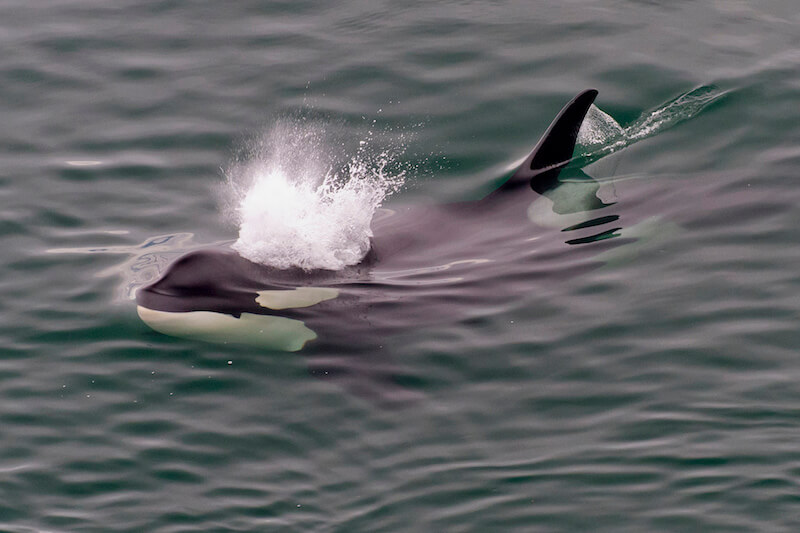“Is it possible to see a killer whale in Saint-Siméon in the Charlevoix region?”, asks a camper who notices a cetacean “with a white spot at the base of its long dorsal fin” on July 24. Killer whales do have this physical characteristic, which distinguishes them from all the others. However, records of these large dolphins in the Gulf of St. Lawrence and its Estuary are rare and sporadic, with only about twenty observations since the early 1980s. The most recent sighting in the Estuary dates back to 2003, off the coast of Les Bergeronnes. Although the chances of observing this whale in the Estuary are low, they do increase along the Basse-Côte-Nord and the Strait of Belle Isle.
Perhaps it was a surface feeding minke whale showing the lobe of its tail (which can resemble the large dorsal fin of a killer whale and a portion of its black back and white belly? They can be deceptive!
On July 17, another witness advises Marine Mammal Emergencies of a killer whale in the Saguenay Fjord. Unfortunately, no sighting is reported in the days that follow and there is no photograph to support it. A photo or expert confirmation is necessary in such cases to validate the observation.
On July 24, again in Saint-Siméon, a second observer writes to the GREMM team that he thought he had spotted a northern bottlenose whale 500 m west of the wharf and about 2 km offshore. He sees the animal dive three times and the front of its head appears white. Also, the position of the dorsal fin intrigues him. The observation is all over in just a few seconds, without any photo.
Bottlenose whales are extremely rare. Since 1994, fewer than 10 individuals have been found stranded on the shores of the St. Lawrence. When they surface, their barely visible spout is balloon-shaped and one can see a beak and melon emerge – the latter being pale in males. Measuring between 6 and 10 m long, they are similar in size to minke whales. The sickle-shaped dorsal fin is positioned two-thirds of the way down the back.
Although the chances of crossing paths with beaked whales or killer whales are slim in our region, it is not impossible. In 2016, a narwhal spent several weeks in the Estuary and in 2013, a Sowerby’s beaked whale was found beached at Île aux Pommes (article in French).
Occasionally, some animals stray from traditional feeding areas to discover new places, thus increasing the number of observations. This is thought to be the case for North Atlantic right whales in the St. Lawrence in recent years. The identity of the young right whale observed last week in the Mingan region by the Mingan Island Cetacean Study (MICS) team was revealed by scientists from the Anderson Cabot Center for Ocean Life at the New England Aquarium: it is 7-year-old male no. 4042, last spotted in the St. Lawrence in 2015.
This week, two blue whales were seen in the Saguenay-St. Lawrence Marine Park. One of them was identified as the female B197. Blue whales are regularly seen in the St. Lawrence, but they are still rare on a larger scale. These blue whales belong to the North Atlantic population, which is estimated at between 600 and 1,500 individuals.
The behaviour of certain individuals also sparks the curiosity of the observers. In Percé, near Bonaventure Island, a park warden gawks at the aerial prowess of a minke whale on July 21. René Roy, in his most recent Field Notes, shares his memorable sighting of the breaches of the humpback H840 and the calf H753 near Gaspé Bay.
Whales, by their simple presence or by their behaviour, offer unforgettable moments to those who encounter them.





